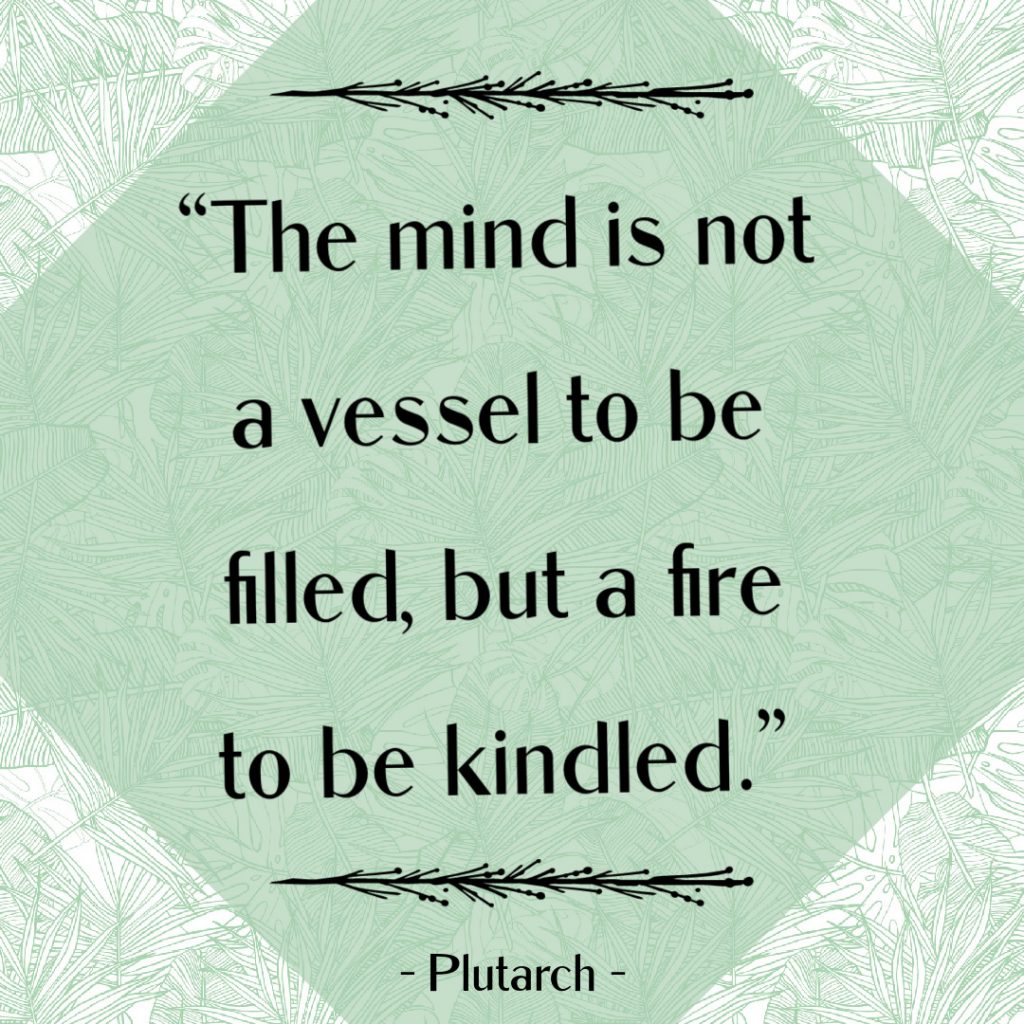In a recent post, I shared the why and the how of my latest efforts to cut down on screen time. This endeavor has rendered countless benefits, key among them an opportunity to become reacquainted with my mind: without the constant distraction of my phone, I’m spending a whole lot more time in my head these days!
Unfortunately, for me—and for many of you too, I’m sure—my head isn’t always a safe place. When left to its own devices, my mind is prone to wander into unhelpful and often unhealthy territory. (After all, there is usually a REASON [beyond simple boredom] for wanting to distract myself with my phone.) Without a safe space to land, my wayward thoughts tend to stray into benign but ultimately unproductive areas (such as endlessly looping through my to-do list). And when I’m not at my emotional best, my thoughts like to make a bee-line for obsessive spirals into anxiety, depression, and shame.

To combat this rumination and destructive thinking, it has been helpful for me to have an “activity menu” for my brain that I can turn to when I find myself without a mind-occupying task before me and I would rather not distract myself with a screen. This menu includes a range of exercises, mental practices, and general thought experiments that will flood my mind with positive things so that I do not fall prey to unhelpful thinking.
I’ll be the first to acknowledge that this need for a list of things to think about is pretty comical (or is it tragic?). After all, people have been thinking things for all of history. The mere option for effortless distraction is a startlingly new phenomenon—one that didn’t exist just twenty or even ten years ago—and before the advent of the smart phone, we all knew how to think. Sadly, those mental skills have slowly slipped away from me. My mind has grown lazy as I have succumbed to the easy distractions of the digital world.
In working to rebuild my own mental muscles in recent months, I have found scheduling out my thought life to be a lifeline. Ultimately, the goal is that I will outgrow such cognitive premeditation as healthy thought habits become my default setting. For now, I am thankful for my curated list of thinking options to choose from.

SPIRITUAL
PRAY: Simply put, talk to God. Tell Him about your day. Ask questions. Make requests. Let the words flow, or riff on memorized prayers.
RECITE SCRIPTURE: Mentally walk through scriptures that you have hidden away in your heart. Reflect on each word and its meaning. Pray through these verses and ask God to reveal new truths within them.
TELL THE TRUTH: List things you KNOW to be true. Recite the Apostle’s Creed. Identify core facts from Scripture that apply to today’s circumstances.
PRACTICE GRATITUDE: Make a list of things you are grateful for, especially related to things you are tempted to complain about. (Example: I am thankful for this period of boredom because it is giving me a chance to exercise my spiritual and mental muscles in new ways.)
WORSHIP: Sing worship songs (out loud or in your head). List the attributes of God, praising and thanking Him for each one.
LISTEN TO GOD: Spend time reveling in His presence. Leave space for Him to speak something new into your heart.
CREATIVE
MAKE A LIST: Select a category and list as many things in it as you can: ice cream flavors, favorite movies, funny book titles, party themes, anonymous acts of kindness, places to visit, ideas to explore further. . . .
TELL A STORY: Write a story in your head. Start with your own premise or build off of a familiar one. Be as fantastical or as realistic as you would like.
WRITE A POEM: Write a mental haiku or acrostic. Create a riddle, a sing-song rhyme, or an aphorism. Put new words to a familiar poem or children’s book.
DRAFT A POST: Plan out your next blog post (or Instagram caption). [STOP this activity immediately if it begins to prompt anxiety or stress! It can wait until you are in a better creative space.]
DREAM: Imagine the future—what would you like life to look like in twenty years? What are some of your bucket list items? Or re-imagine the present—where would you like to be right now, and what would you like to be doing? Build in as many sensory details as possible.
ACADEMIC
RECITE FACTS: List the presidents, the state capitals, shades of color on the rainbow, or animal species. Recite memorized poems or passages of literature or parts of historical speeches.
SOLVE A PROBLEM: Attempt to mentally solve multiplication or division problems. Calculate fractions or percentiles. Ponder a scientific quandary. Mentally diagram a sentence.

MINDFUL
FIVE-SENSE OBSERVATION: Notice five things you can see, four things you hear, three things you feel, two things you smell, and one thing you taste. Describe each sensation multiple ways (through varied vocabulary or poetic imagery).
WALK IN THEIR SHOES: Observe the people in the room and imagine the current setting/situation through their eyes (physical and metaphorical).
NARRATION: Put words to your surroundings as if you were describing your current to someone who is blind or deaf. Note as many details as possible.
BODY PRESENCE: Identify how you are feeling in each part of your body, beginning with the top of your head and working your way down to your toes.
FUN
MAKE YOURSELF LAUGH: Tell yourself a joke. Recall a funny scene from a movie. Imagine humorous outcomes to situations that currently seem dire.
PLAY A GAME: Make up words. Count or alphabetize items in the room. Make up funny backstories for people you don’t know very well. Dream up pretend facts for a game of Two Truths and a Lie.
PERSONALITY-TYPE: Contemplate the Enneagram or Myers-Briggs types of fictional characters or inanimate objects.
NAME IT: Make up new (and funny or creative) names for the items around you, or for people you know.
REFLECTIVE
VISIT MEMORIES: Scroll through your album of mental polaroids; select a memory (from childhood or something more recent) and recall as many details as you can. Who was there? How did you feel [or what were you thinking] at the time? How do these memories inform who you are today?
TELL YOUR STORY: Walk through your life’s biggest events as if you were sharing your story with a new group of friends. Tell the elevator version, then work your way up to the multi-volume autobiography account.
MENTAL JOURNALING: Imagine you are sitting down with your journal and put words to the events of the day and your thoughts about them.
WEEKLY/MONTHLY/SEASONAL/ANNUAL EXAMEN: Think back over a specific stretch of time. What were the highs and lows? What did you learn? What will you be taking with you moving forward, and what would you like to leave behind?

This list is not exhaustive, but it IS a good place to start when I have some mental time to fill. I am still learning which exercises work best for me and when/how to use them. For instance, when I am on the verge of a panic attack, reflection and even spiritual practices can trigger new anxieties; in those times, exercises within the Academic category are most helpful (listing the presidents was a lifesaver for me for a few weeks in January). When falling asleep at night, I like to select from the Reflective brain prompts. Mindfulness is great when I am in a public setting. Creative thinking is perfect for when I’m folding laundry or on a walk, and the Spiritual practices are crucial for getting through challenging moments with my kids.
I would love to hear from you: have you experienced this same atrophy in your own ability to simply “be in your head?” Are you doing anything to combat this decline? When your mind has a chance to wander, what do you like to think about?